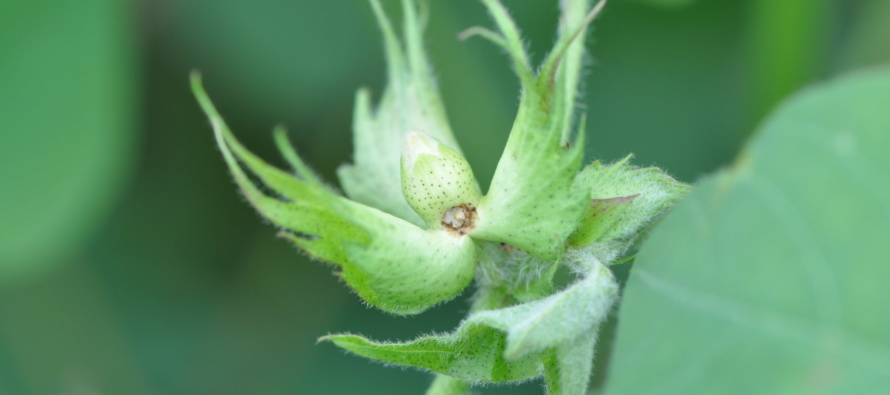Bollworm Moths and Eggs Plentiful in Cotton: How Aggressive Should We Be?

Related Articles
- Fertilizing Cotton with Poultry Litter 5
- Mississippi Cotton Insect Situation of 2010: A Look Back 3
- Bayer CropScience-O.A. Cleveland Weekly Cotton Commentary 0
Latest Tweets
For the last 7-10 days we have flushed numerous bollworm moths in cotton around the state and are commonly picking up eggs and small larvae in places. We have had numerous calls from consultants seeing the same thing and several have already reported square damage and damage to small bolls under bloom tags. We have seen more bollworms successfully come through early planted Bt corn this year than ever before. My concern is that these moths have been preselected for tolerance to the Bt toxins and we could see greater survival in Bt cotton.
So how do we handle bollworms in Bt cotton in 2017? This is the million dollar question. We can only advise on what we have seen and experienced to date.
What we know.
- We are seeing more square feeding in BG2 cotton than we have seen in the past. We have always had some escapes, but we are seeing worms that originate in the terminals and start hitting squares as neonates. This is not normal. This was not common even in BG1 cotton. This is fairly new and we are seeing more every year.
- Resistance assays from 2016 performed by LSU suggest that we are seeing a change in susceptibility with bollworm to both Cry1Ac and Cry2Ab. It is not complete resistance, but this means that we can expect to see even more damage in the future unless there is some fitness cost that would prevent it from spreading throughout the populations.
- WideStrike cotton performs very poorly against bollworm.
- WideStrike 3 cotton has an extra gene that greatly improves its performance over regular WideStrike. It puts in on par with BG2 and maybe even a little better. Don’t confuse the two.
- When bollworms are allowed to get inside bloom tags, control with foliar insecticides is generally less than 50% with perfect applications.
What to use.
- Pyrethroids perform poorly against bollworm in the Mid-South region and are no longer recommended for control in any crop. However, if the stars align and you hit a hatching neonate you will likely get ‘OK’ suppression. So if you are targeting tarnished plant bugs and adding a pyrethroid to enhance control, you will see some efficacy against bollworm but its risky relying on this alone.
- Diamides (Prevathon 14-20 oz., Besiege 7-10 oz.) are the products of choice for bollworm control in cotton. Intrepid Edge is beginning to get some use. I have limited data on this in cotton but based on what I have seen in soybeans it will likely be an option but will need a 5-7 oz. rate and I would lean toward the 7 oz. rate in cotton.
- Remember there is nothing magic about the diamides. If pressure is not there, you will not see a yield response.
- If you are targeting established worms in a cotton canopy, you will likely NOT zero them out, even with a diamide. I have never been successful zeroing out established worms. Mange your expectation on rescue treatments.
When to use it.
- This is where it may get controversial. We have never really had an egg threshold in cotton. However, given that we now can confirm resistance to the traits, documented numerous survivors from Bt corn that have now been preselected for likely increased survival in Bt cotton this year, and already documented damage in Bt cotton this year, I would say the likelihood of an egg laid on bloom tag of Bt cotton has a high probability of surviving and causing damage. With this in mind and knowing that once a worm gets established inside a bloom, square, or boll that control is greatly reduced even with the very best products due to them feeding in protected places, we would suggest being more proactive on acres with heavy egg lays.
- The following are what we would recommend on the various technologies: WideStrike Cotton: Treat on 10-15% egg lays on bloom tags, BG2 cotton: Treat on 25-30% egg lay on bloom tags. WideStrike 3: I simply do not have enough data to know if this is warranted yet on this trait package. However, I do know that this trait package will also need to be scouted closely and treated on threshold.
- Its too early to tell right now how long this flight will last but ironically the good news is that all of the replanted cotton is not yet flowering or just started. I would not use egg thresholds in cotton that is not flowering or that just started.
- So the pushback against these recommendations will always be “You didn’t give the techonolgy a chance to work”. Yep that is true if you use an egg threshold no doubt. However, due to a variety of factors that influence survival of bollworm in Bt crops, I think that we are now in a different situation than we have been in the past. Additionally, we have received numerous reports from our colleagues in Texas and Louisiana about unusually high numbers of escapes in all Bt cotton technologies this year. The larval thresholds for MS are 4% infested plants or 2% damaged bolls with worms present if you choose to go that route…..




Let me tell You a sad story ! There are no comments yet, but You can be first one to comment this article.
Write a comment